This post is co-authored by Ditch That Textbook’s Matt Miller and Laura Steinbrink. Laura is a high school English teacher and tech coach from Plato, Missouri. Check out her blog, Rockin’ the Boat, at rockintheboat.com.
If you are like me (Laura), you are constantly searching for a new, fresh activity to help connect your students with your content.
Time is always a factor though, so I look for things I can immediately implement without spending a lot of my time preparing it, and I want it to be a relatively quick activity for my students too.
If that sounds like you, then Matt and I have you covered! We have four activities that are similar, involve different levels of thinking, and will keep your students engaged.
I (Laura) am a big believer in spacing out my use of a tool or activity so that I am not pounding students with the same thing every day, week, and beyond. If you use the same type of activity over and over again, your students may soon hate the tool -- and you may, too!
Google Slides and Google Drawings are amazing and among our favorite tools. Here are the four activities to keep your students out of “not this again” mode. They can be used as a bell ringer, exit ticket, a demonstration of learning, or more.
NOTE: Which one do you pick -- Google Slides or Google Drawings? Honestly, there's not much difference between them, and for this activity, you could probably use either. Here are the main differences, so you know which fits best for you:
- Google Drawings: Like a digital poster board or paper. Made for just one image. If everything you plan to do goes on one image/slide, Google Drawings is great.
- Google Slides: Made for having multiple slides in one presentation. (Think: a stack of posters or papers.) If you want to have multiple separate images in one place, use Slides and put each one on a different slide.
- For the purposes of this blog post, we'll use the term "Google Drawing," but know that you can use Google Slides, too.
While these activities don’t have to be done in this order, it does make it easier for the students if you do implement them in order.
Caption this! A fun activity you can use tomorrow.
Activity 1: Annotate
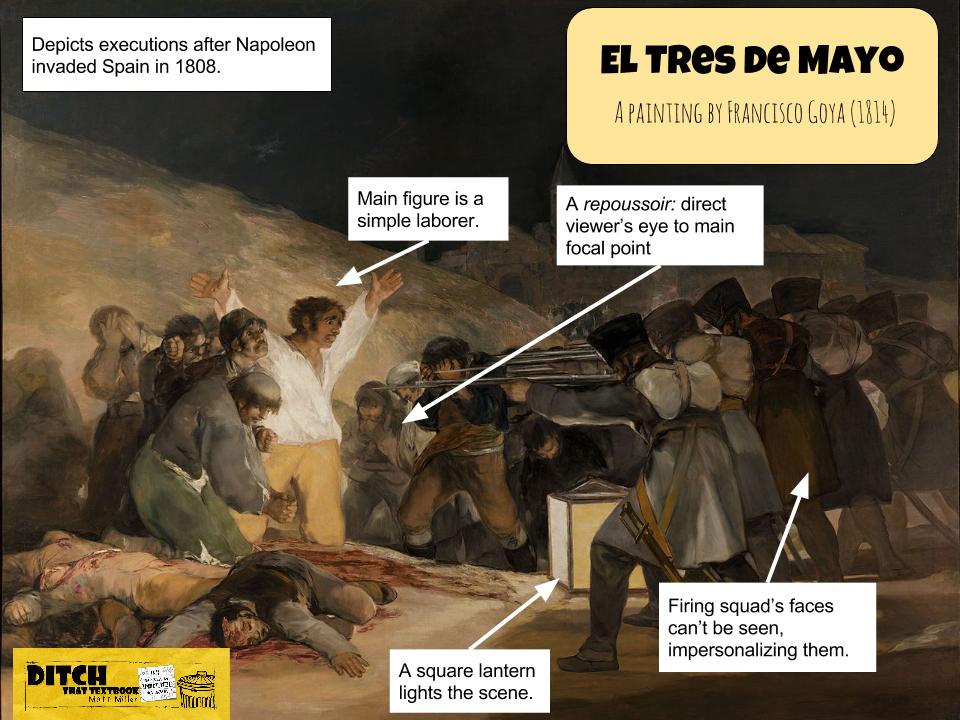
Students can label parts of an image that they know, find relevant or think are interesting. Use arrows and text boxes (or arrow shapes!). See how below.
- PRO TIP: Want to set students up with a specific image? Instead of having them create the Google Drawing, I (Matt) would create one myself and add the image you want them to use. Then I'd attach that Drawing to a Google Classroom assignment and choose "Make a copy for each student." That eliminates some steps and gets students right to work.
- Add text boxes next to the arrows to describe what the arrows are pointing to. This is where students will show what they know, what they find interesting, etc. You'll want to change the background color of the text box if it's transparent (use the paint bucket icon at the top after you've clicked on the text box).
- PRO TIP: Instead of using arrows and text boxes in the step above, use an arrow shape! Go to "Insert" and "Shape" and "Arrows" and add one you like. Double-click the arrow to add text to it. It can add some visual appeal AND the background is already a solid color (white) so it's not transparent and doesn't blend into the image!
- When they're done, have students turn the image in to you via Google Classroom (or however you collect digital work).
WHY THIS WORKS: It's basic constructivism! Constructivism, at its core, says that students make meaning of something new when they're able to construct it in their minds. What better way to construct meaning than to make something that shows what your brain is thinking?
Annotate template (As an example ... maybe best having students add their own text and arrows instead of using this as a template.)
Activity 2: Caption This!
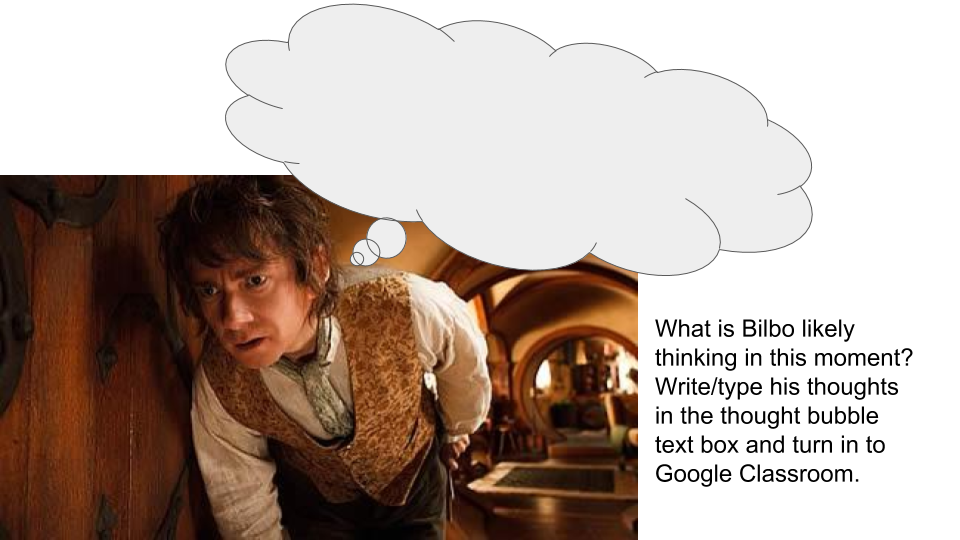
When you add a speech bubble or thought bubble to an image, you let students speak or think for the subject of the photo.
Understanding different viewpoints is also a great way to delve deeply into a topic. When students can take the place of the person in the image, it helps them see what's happening in a whole new light.
- Select a picture that either introduces your current lesson focus or is key to your subject for the lesson and let students caption it. You can add the image to a Google Drawing and share it with students through Classroom (see the first "pro tip" in Activity 1 above). OR, you can have students create a new Google Drawing and add the image themselves.
- Add a thought bubble or speech bubble. Give students a prompt for filling in the bubble, or give them freedom!
- When they're done, have students turn the image in to you via Google Classroom (or however you collect digital work).
WHY THIS WORKS: This activity requires more critical thinking than the first. By taking the character's perspective, students make an inference (deduce or conclude from evidence and reasoning rather than from explicit statements). Inferring is on the second level of Webb's Depth of Knowledge (skill/concept). We're adding more critical thinking here!
Caption This Template (Replace the image with one for your lesson and edit the directions.)
Activity 3: Caption This & Comment
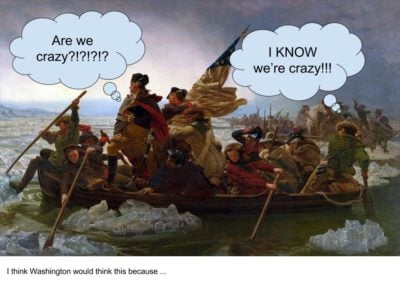
By adding a comment to the "Caption This!" activity, students add an extra layer of deeper critical thinking.
In this third activity, we add a twist. Not only do students think or speak for the person in the photo, they also give that person advice.
- Have students complete Activity 2 above with an image and a caption in a speech/thought bubble.
- OPTION 1: Students write advice they would give the person in the image. (Adding emojis or Bitmojis to their response is encouraged! If you use the Google Chrome browser and need a way to add emojis, I (Matt) like the Emoji for Google Chrome extension.)
- Extra advice from Laura: You could have a Bitmoji or an Emoji face/sticker give advice to the character in the picture. The Bitmoji can be without text if the student will add a text box and create the text. The Bitmoji or Emoji sticker must give advice, not just an agreeing type of commentary.
- OPTION 2: Students explain their thinking by describing why they wrote what they did in the speech/thought bubble (like the "Washington Crossing the Delaware" example above ... except with possibly more intellectual quotes in the bubbles!).
- When they're done, have students turn the image in to you via Google Classroom (or however you collect digital work).
WHY THIS WORKS: We continue to build to higher levels of critical thinking. "Draw conclusions" and "develop a logical argument" are examples of the third level of Webb's Depth of Knowledge (strategic thinking).
Caption This & Comment Template (Replace the image with one for your lesson and edit the directions.)
Activity 4: Picture This and Take a Stance
Let’s take our students another step further into learning. Now, instead of asking students to write a quote, let's start with a quote!
- Find a quote from your content or a character/historical figure and add it in a speech/thought bubble to a Google Drawing. Share it with students via Google Classroom (see Activity 1 pro tip above) or have students create a Google Drawing with the quote you provide.
- Students add a picture that illustrates the quote. They can find an image using "Insert" and "Image" and "Search the web."
- Students explain the scene. (If using Google Slides, students can use the speaker notes. You may need to discuss the speaker’s notes section if they have never used it before. If using Google Drawings, students can add a text box or a shape at the bottom of the image for typing text to explain the scene.)
- Once they have added their explanation of the scene, then they form an opinion/take a stance and write about their opinion/stance. You can even ask students to add a Bitmoji, avatar, emoji or other image that represents how they feel. and have it take a stance. (Note: Some Bitmoji images are inappropriate for younger children. You might want to use emojis instead OR just download some Bitmoji images in a Google Drive folder you can share with students.)
- When they're done, have students turn the image in to you via Google Classroom (or however you collect digital work).
WHY THIS WORKS: Giving students time to reflect about what they've learned, form opinions about it and explain/defend those opinions helps them to own and retain new material. Plus, they're still doing critical thinking on the third level of Webb's Depth of Knowledge (strategic thinking).
Picture This & Take a Stance Template (Replace the image with one for your lesson and edit the directions.)
BONUS: A math example!

Using a "Caption This!" activity in math helps students think through their mathematical processes. It also provides a place where they can express what they struggle with, what is easy, and what they don't understand.
So often, I (Matt) work with math teachers in trainings that wonder how activities like these could be used in the math classroom.
A "Caption This!" activity could have great benefits in the math classroom! Seeing how students think through a math problem can give great insight into how well they understand certain concepts.
Plus, if they can express their feelings about certain types of problems -- and help us understand which parts they don't get -- this can help us as teachers help them more clearly.
After working a problem, students can take a picture of it with their webcam using the Alice Keeler Webcam Snapshot extension for Google Chrome. Insert that image into the Google Drawing and add description, thoughts and reflections on top.
How could you use this in your class? What changes would you make to it? Please leave your thoughts in a comment below!
For notifications of new Ditch That Textbook content and helpful links:
Are you looking for quality, meaningful professional learning that both equips and inspires teachers?
Matt provides in-person and virtual keynotes, workshops and breakout sessions that equip, inspire and encourage teachers to create change in their classrooms. Teachers leave with loads of resources. They participate. They laugh. They see tech use and teaching in a new light. Click the link below to contact us and learn how you can bring Matt to your school or district!
Is Matt presenting near you soon? Check out his upcoming live events!

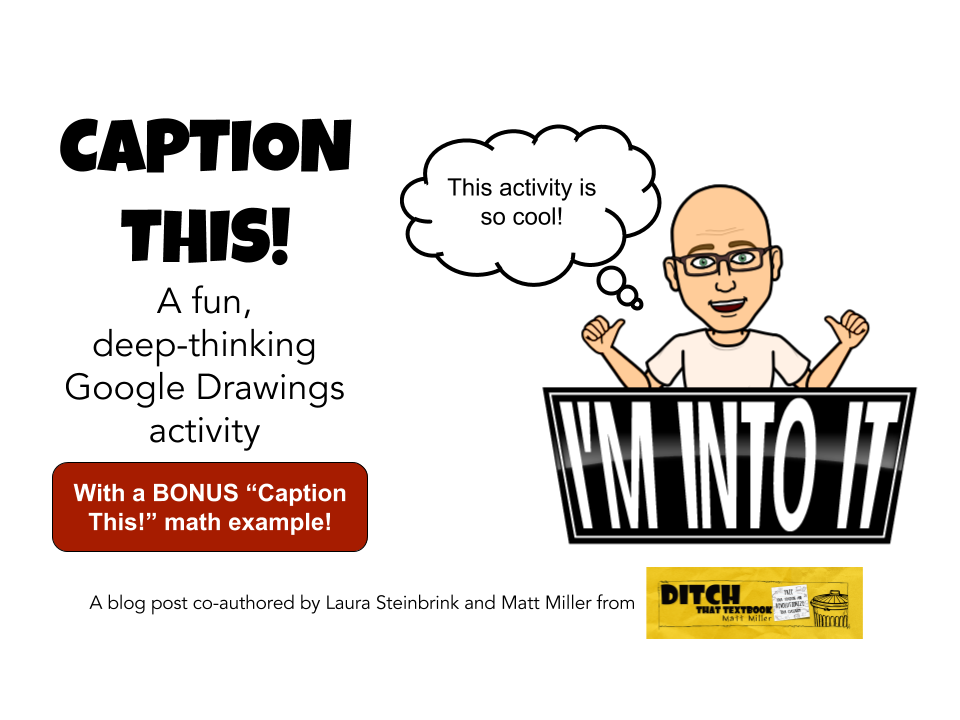
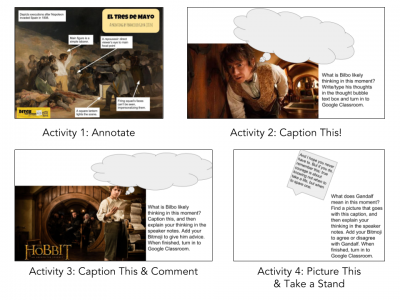
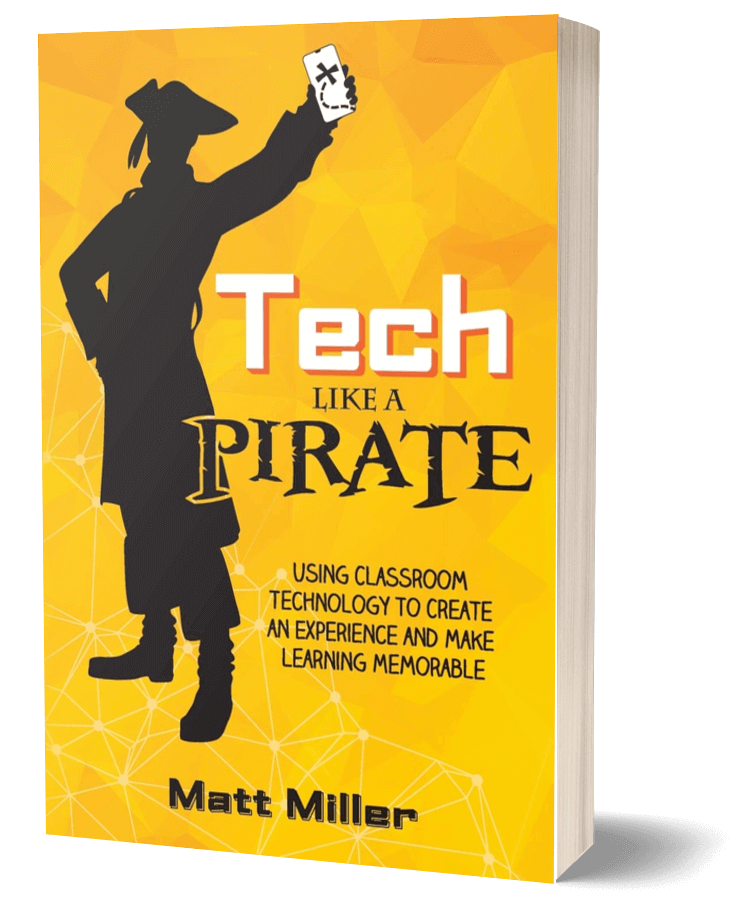



[…] Read: Caption This! A fun, deep-thinking Google Drawings activity […]
[…] Express a thought or summarize an image by annotating in Google Drawings with a […]
Love these ideas!! Is everyone just using random pictures they find if bell ringer activity?
These are some awesome ideas I plan on sharing during these last weeks of school and when we get back in the building! Thanks for sharing!
[…] Caption This Activity with Google Drawings (Laura Steinbrink and Matt Miller) […]
I already use this in my co-teaching ELA classroom! We put up a bellringer on the smart t.v. with stickers and interactives for our EL curriculum Learning Targets. It gets the kids engaged immediately and is different everyday to increase critical thinking in connection with our book. The middle schoolers like the creative and funny tech use of Bitmojis! It is communication without having to nudge.
Your ideas are the bomb!